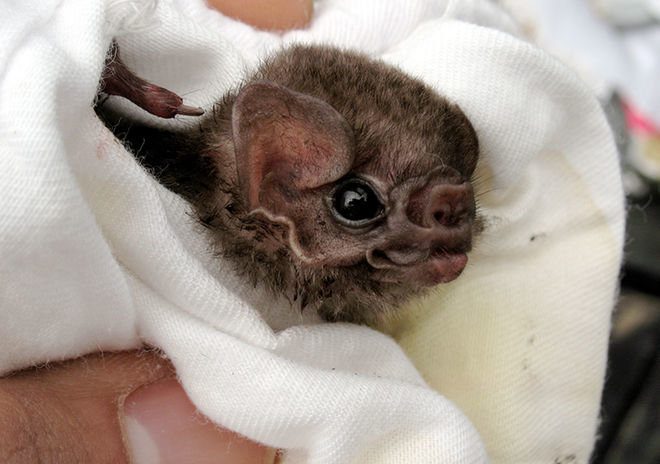
© Gerry CarterA hairy-legged vampire bat (Diphylla ecaudata), captured in Mexico.
Unlike mythical vampires,
vampire bats do not prey on humans — or do they? Scientists have found the first evidence of vampire bats supping on human blood.Diphylla ecaudata, also known as the hairy-legged vampire bat, inhabits forests in northeastern Brazil and is one of three species of vampire bats that feed only on blood. It was thought that birds were its sole prey, but dung analysis recently revealed that other types of two-legged animals — humans — were on the bat's bill of fare.
The bats' feeding preferences may have shifted because birds were hard to find, hinting that even highly specialized bats could have more flexibility in their diets than expected, the study authors wrote.
Vampire bats, which live only in the Americas, feed by puncturing the skin of their prey with sharp incisors and lapping up the flowing blood, mixing it with saliva that prevents their gory meal from coagulating too quickly. Previous studies have shown that these bats don't store fat in their bodies and can't survive without food for more than a couple of days.
The scientists were curious about how a bat that depends on birds and must eat every two days would modify its feeding behavior if its prey of choice were less available. To find out what else
D. ecaudata might be eating, they collected 70 fecal samples from a colony living in a cave in Brazil's Catimbau National Park, and extracted DNA to identify the bats' most recent meals.
It's people!Their analysis revealed that the bats were feeding on chickens
and, more surprisingly, on humans. D. ecaudata is adapted to consume bird blood, which has higher water and fat content than mammal blood, and lower concentrations of proteins. It is possible that the bats couldn't survive on human blood alone, and had to seek out at least some blood from birds — even if those birds weren't their usual prey, the researchers noted.
Domestic animals and people usually live close together in that region, making it easier for the bats to grab a quick bite from whoever is available. Birds may be growing scarce in the forests where the bats live because of human activity. About half of the 510 species of native birds living in Brazil's Caatinga — the vast forest region that is partly contained in Catimbau National Park — are described as moderately to highly sensitive to disturbance by humans, according to an earlier study.
Unraveling the circumstances that led
D. ecaudata to rely on human and chicken blood would be "an interesting ecological exercise," the study authors wrote.
But the prospect of vampire bats feeding on humans also raises concerns about public health, as it could bring an increased risk of rabies transmission, the researchers said.The findings were published online in the December 2016 issue of the journal
Acta Chiropterologica.
of supping on human blood", my ass. They have ALWAYS preyed on humans when they could get away with it.